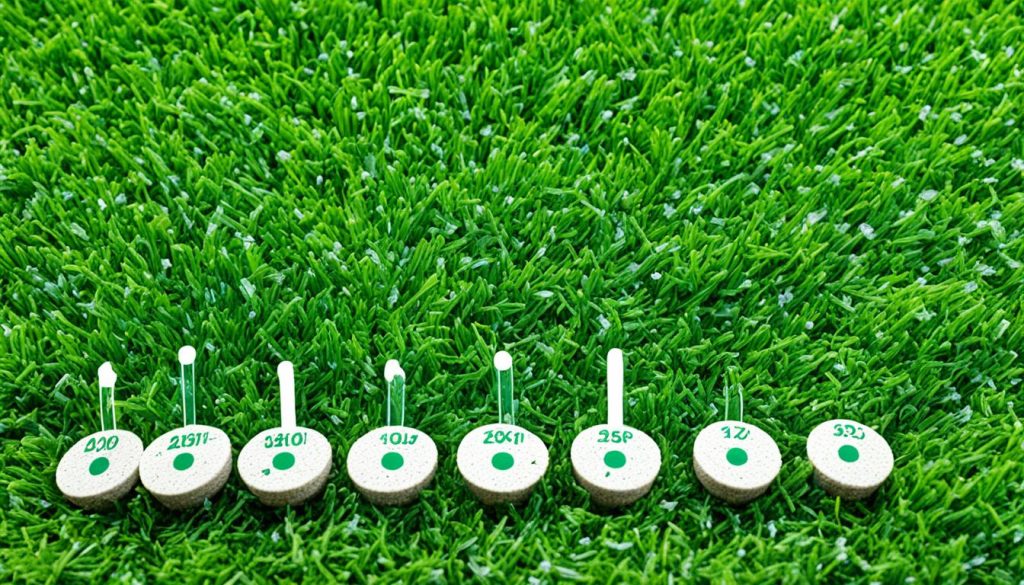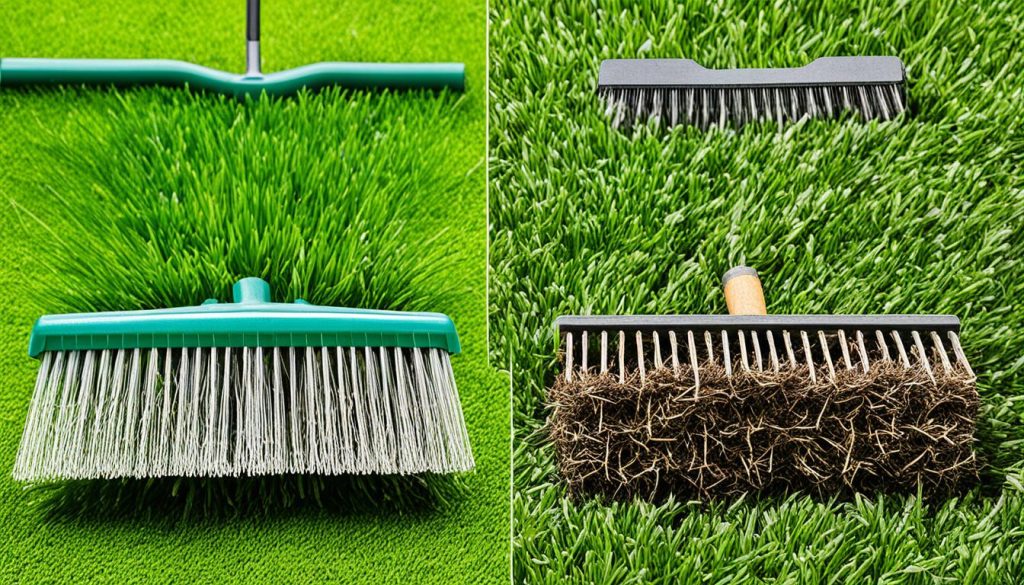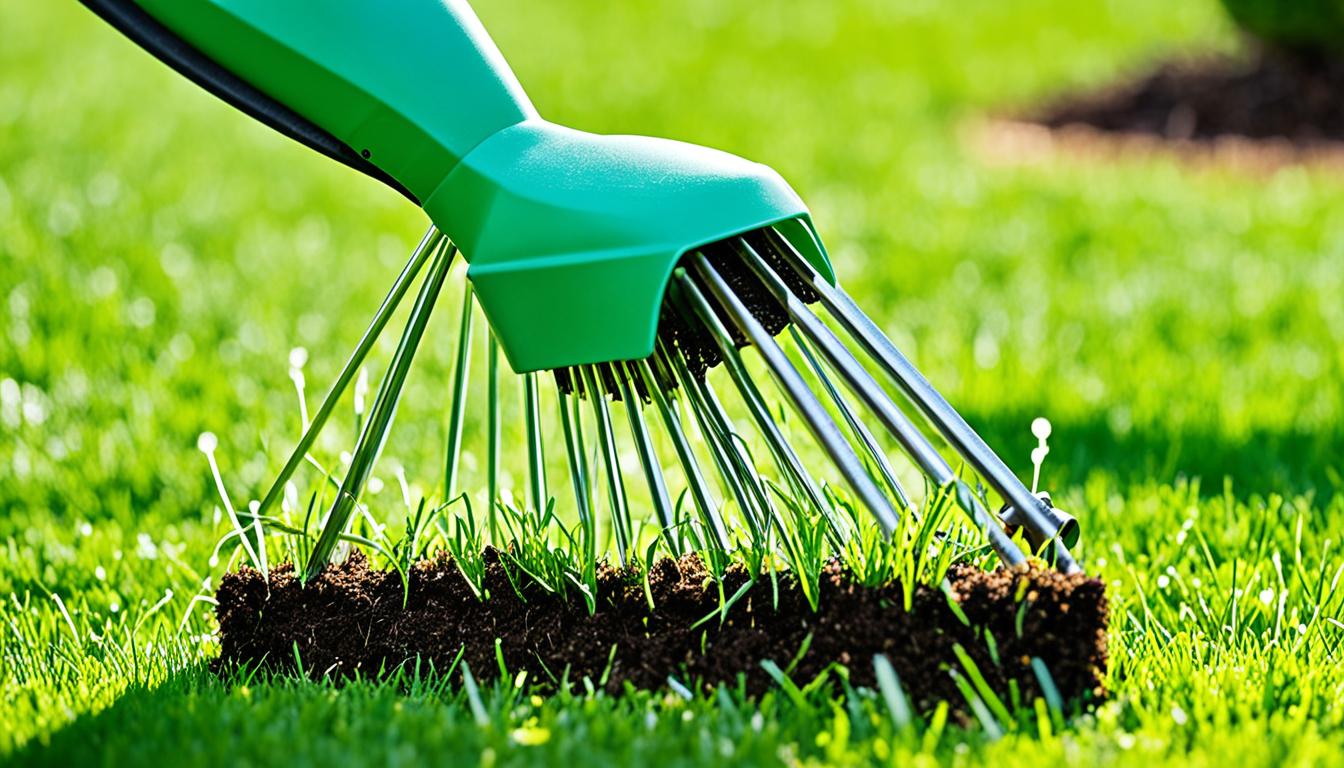A lush, green lawn is a dream for many homeowners. However, achieving and maintaining that vibrant green carpet requires proper care and attention. One essential practice for keeping your lawn healthy is aerating it regularly. But how often should you aerate your lawn to ensure optimal results?
Aeration involves creating small holes in the soil to allow air, water, and nutrients to penetrate the roots of the grass. This process helps reduce soil compaction, manage thatch levels, and promote root growth. However, the frequency of lawn aeration depends on several factors, including soil compaction, soil type, and grass species.
While many experts recommend aerating your lawn annually, there are instances where more frequent aeration may be necessary. But what are those instances, and how can you determine if your lawn needs more frequent aeration?
Join us as we delve into the world of lawn aeration, exploring the factors that affect the ideal aeration schedule and uncovering the secrets to maintaining a lush and healthy lawn.
Key Takeaways:
- The frequency of lawn aeration depends on factors such as soil compaction and grass species.
- The general rule of thumb is to aerate your lawn annually.
- Lawns with compacted soil may require more frequent aeration.
- Consulting a lawn care expert can help determine the best aeration schedule for your specific lawn.
- Aeration helps reduce compaction, manage thatch levels, and promote root growth.
Benefits of lawn aeration
Aeration provides numerous benefits to your lawn. It helps to reduce soil compaction, which allows for better air and water circulation in the soil. This improves nutrient absorption and promotes healthy root growth. Aeration also aids in managing thatch levels, preventing the buildup of dead grass and debris. By aerating your lawn, you can increase turf density, improve overall lawn health, and make it more resistant to stressors such as heat and drought.
When to aerate your lawn
The timing of lawn aeration is crucial for its effectiveness. It is important to choose the right time to aerate your lawn to ensure maximum benefits. The ideal timing depends on the type of grass you have in your lawn and the climate of your region.
For cool-season grasses:
- Early spring: This is the prime time to aerate cool-season grasses. As the grass starts actively growing, it can quickly recover from the aeration process. Aeration in early spring helps improve root development and prepare the lawn for the upcoming growing season.
- Fall: Fall is another suitable season for aerating cool-season grasses. Aeration in the fall allows the grass to recover from summer stress and promotes healthier root growth before the winter dormancy period. It also helps prevent thatch accumulation during the dormant season.
For warm-season grasses:
- Late spring: Late spring is the recommended time to aerate warm-season grasses. By this time, the grass is actively growing and can quickly recover from the aeration process. Aeration in late spring promotes root development and overall lawn health throughout the summer.
- Early summer: Early summer is another suitable time for aerating warm-season grasses. By aerating in early summer, you give the grass enough time to recover and strengthen before facing the heat and stresses of the peak summer months.
It is essential to avoid aerating your lawn during periods of extreme heat or cold, as the grass may struggle to recover properly. Additionally, it is always recommended to consult a lawn care professional who can assess your specific grass type and climate conditions to determine the best time for aeration.
Remember, timing is key when it comes to aerating your lawn. By aerating at the right time, you can provide the best conditions for your grass to thrive and maintain a healthy and lush lawn.
How often to aerate your lawn
The frequency of lawn aeration depends on factors such as soil compaction and grass species. In general, it is recommended to aerate your lawn annually. This is especially true if your soil is compacted or if you have high traffic areas on your lawn. Lawns with clay or silt soils may also require more frequent aeration. Consulting a lawn care expert can help determine how often you should aerate based on your specific soil conditions and grass type.

Factors influencing lawn aeration frequency
- Soil compaction: Lawns with compacted soils may require more frequent aeration to alleviate compaction and improve soil health.
- Grass species: Different grass species have varying needs when it comes to aeration. Some may benefit from more frequent aeration than others.
- Soil type: Lawns with clay or silt soils tend to be more prone to compaction and may need to be aerated more often.
- High traffic areas: If certain areas of your lawn experience heavy foot traffic, such as pathways or play areas, they may require more frequent aeration to mitigate compaction and maintain healthy grass growth.
By understanding these factors and consulting with a lawn care professional, you can determine the ideal lawn aeration schedule for your specific lawn, ensuring its health and vitality.
Lawn recovery after aeration
Proper post-aeration care is essential for the recovery of your lawn. To ensure optimal results, follow the following lawn care tips:
- Continue regular mowing: Mow your lawn as usual, maintaining the recommended grass height. This helps the grass to recover and promotes uniform growth.
- Provide adequate irrigation: Water your lawn regularly to prevent it from drying out. Adequate irrigation is crucial for the successful recovery of a newly aerated lawn.
- Consider overseeding: For cool-season lawns, overseeding alongside aeration can enhance turf density and accelerate the recovery process. Choose high-quality grass seed that matches your existing lawn variety.
Here’s an example of an overseeding schedule after aeration:
| Day | Action |
|---|---|
| Day 1-3 | Lightly water the newly aerated lawn every few days to prevent seed drying. |
| Day 4-10 | Continue light watering and monitor seed germination. |
| Day 11 and onwards | Resume regular watering schedule according to your lawn’s needs. |
Once the newly seeded grass has germinated and established, you can resume your regular watering routine. Like any newly seeded area, the overseeded sections may require extra care and attention until they are fully established.
By following these lawn maintenance tips, you can ensure a successful recovery of your lawn after aeration.
Lawn aeration versus dethatching
Lawn aeration and dethatching are two different practices that serve different purposes. Aeration involves removing small plugs of soil to reduce compaction and improve soil health. Dethatching, on the other hand, focuses on removing the layer of dead grass and debris that accumulates above the soil line. While both practices can benefit your lawn, they address different issues. Aeration is recommended for improving soil structure, while dethatching is recommended for managing thatch buildup. Consulting a lawn care professional can help determine which practice is needed for your specific lawn.
When it comes to maintaining a healthy and vibrant lawn, understanding the difference between lawn aeration and dethatching is crucial. These two practices play distinct roles in improving different aspects of your lawn’s well-being. It is essential to identify the specific needs of your lawn to determine which method will be most effective. Let’s explore the differences between lawn aeration and dethatching and how they can contribute to the overall health of your lawn.
Aeration for Soil Health
Aeration is the process of creating small holes or removing plugs of soil from your lawn’s surface. This practice is primarily aimed at reducing soil compaction and improving the health of the soil. Compacted soil restricts the movement of air, water, and nutrients, making it challenging for the grass roots to access the essential resources they need to thrive. By aerating your lawn, you can improve soil structure, increase soil porosity, and enhance the overall health of your grass.
During aeration, the cores or plugs of soil that are removed from the lawn’s surface create pathways for air, water, and nutrients to penetrate the soil more effectively. This allows the grassroots to access these resources, promoting healthy growth and development. Additionally, aeration helps to break up dense, compacted soil, allowing for improved root development and deeper root penetration, making your lawn more resilient to stressors such as heat and drought.
Dethatching for Thatch Management
Dethatching, on the other hand, focuses on managing the layer of dead grass, roots, and other organic debris that accumulates between the grass blades and the soil surface. This layer, known as thatch, can become thick and compacted over time, hindering the grass’s ability to receive adequate air, water, and nutrients. It also creates a favorable environment for pests and disease to thrive.
By dethatching your lawn, you remove this layer of thatch, allowing the grass to grow and breathe freely. This helps prevent pest infestations, disease outbreaks, and other issues that can negatively impact your lawn’s health. Regular dethatching promotes improved nutrient absorption, water retention, and overall lawn vigor.
Determining the Right Approach
Both aeration and dethatching are valuable practices that can benefit your lawn. However, the decision to either aerate or dethatch should be based on your lawn’s specific needs. If you notice signs of soil compaction, such as poor drainage, shallow root growth, or excessive thatch buildup, aeration is likely the best approach. On the other hand, if your lawn has a thick layer of thatch that is impeding its growth and nutrient absorption, dethatching may be necessary.
To determine the most appropriate approach for your lawn, it is recommended to consult a lawn care professional. They can assess the condition of your lawn, analyze soil compaction, and evaluate thatch levels to provide expert recommendations. Their expertise will ensure that you choose the right method and implement it effectively, leading to a healthier, greener, and more beautiful lawn.
Ultimately, both aeration and dethatching contribute to the health and vitality of your lawn. By understanding their differences and consulting with professionals, you can address specific issues and implement the most effective lawn care practices tailored to your unique lawn’s needs.

How to properly aerate your lawn
To properly aerate your lawn and maintain its health, follow these key steps:
- Water the lawn: Before aerating, it’s important to water the lawn to soften the soil. This will make it easier for the aerator to penetrate the ground.
- Mark sprinkler heads and utility lines: Before aerating, mark any sprinkler heads or utility lines in your lawn. This will help you avoid damaging them during the process.
- Choose the right aerator: Use a core aerator to remove plugs of soil from the lawn. This type of aerator is effective in relieving soil compaction.
- Cover the entire area: Make sure to cover the entire area of your lawn with the aerator. This will ensure that all areas receive the benefits of aeration.
- Multiple passes for compacted soil: For heavily compacted soil, it may be necessary to make multiple passes with the aerator in different directions. This will provide better aeration for the soil.
- Leave soil plugs on the lawn: After aerating, leave the soil plugs on the lawn. These plugs will decompose over time, adding valuable nutrients back into the soil.
- Water the lawn: After aerating, water the lawn well. This will help the grass recover and promote the growth of healthy roots.
- Consider soil improvement and lawn food: To further enhance the recovery process, consider applying a soil improver and lawn food after aerating. This will provide additional nutrients to the lawn.
Following these lawn aeration tips will help ensure that your lawn remains healthy and vibrant, promoting optimal growth and root development.
How to properly dethatch your lawn
Dethatching your lawn is an essential part of lawn care to maintain its health and vitality. Lawn dethatching involves the removal of the layer of thatch that accumulates above the soil line. Thatch is a buildup of dead grass, roots, and other organic material that can prevent water and nutrients from reaching the soil. Without proper dethatching, your lawn may become thin, weak, and susceptible to disease.
To properly dethatch your lawn, follow these steps:
- Mow the lawn: Before dethatching, mow your lawn to half its normal height. This will make it easier to remove the thatch.
- Select the right tools: For small lawns, a dethatching rake can be used. These rakes have sharp tines that can penetrate the thatch layer and remove it. For larger lawns, consider renting a dethatcher machine. This machine uses spinning tines or blades to effectively dethatch larger areas.
- Loosen and remove the thatch: Using the dethatching rake or machine, gently rake or pass over the lawn to loosen and remove the thatch. Make sure to apply enough force to separate the thatch from the soil without damaging the grass roots. Work in small sections to ensure thorough dethatching.
- Dispose of the thatch: Once the thatch is loosened, remove it from the lawn. Thatch can be added to a compost pile or disposed of as yard waste.
- Patch bare spots: After dethatching, examine your lawn for any bare spots that may have been uncovered. Use a high-quality grass seed to patch these areas and encourage regrowth.
- Water thoroughly: After dethatching, water the lawn thoroughly to aid in its recovery. This will help settle the soil and promote new growth.
Remember, dethatching should be done when the thatch layer exceeds half an inch in thickness. Performing it in the early spring or fall is generally recommended, as these seasons provide optimal conditions for lawn recovery and regrowth.
| Benefits of Proper Dethatching | Tips for Success |
|---|---|
|
|
By following these lawn dethatching tips, you can help ensure the health and vibrancy of your lawn, allowing it to thrive and provide a beautiful outdoor space for your enjoyment.
Conclusion
Lawn aeration and dethatching are vital components of maintaining a lush and healthy lawn. By incorporating these practices into your lawn care routine, you can ensure optimal soil condition and promote vigorous grass growth. Aeration helps to alleviate soil compaction, allowing for improved air and water circulation, while dethatching aids in managing thatch buildup, preventing it from choking the grass.
When it comes to the frequency of these practices, it is essential to consider your specific soil conditions and grass type. Consulting a lawn care professional will provide tailored advice on the ideal aeration and dethatching schedule for your lawn. Their expertise will help ensure that your lawn receives the necessary care it needs, resulting in a vibrant and healthy outdoor space for you and your family to enjoy.
To maintain optimal lawn health, it is important to follow proper aeration and dethatching techniques. Aerating your lawn involves using a core aerator to remove small plugs of soil, while dethatching requires the removal of the thatch layer using a rake or dethatcher machine. By following these steps and investing time and effort into your lawn care routine, you can achieve a beautiful, green lawn that will be the envy of your neighborhood.
Remember, lawn care is an ongoing process that requires dedication and attention to detail. By regularly aerating and dethatching your lawn and seeking professional guidance when needed, you can ensure that your outdoor space remains healthy, vibrant, and inviting for years to come.





